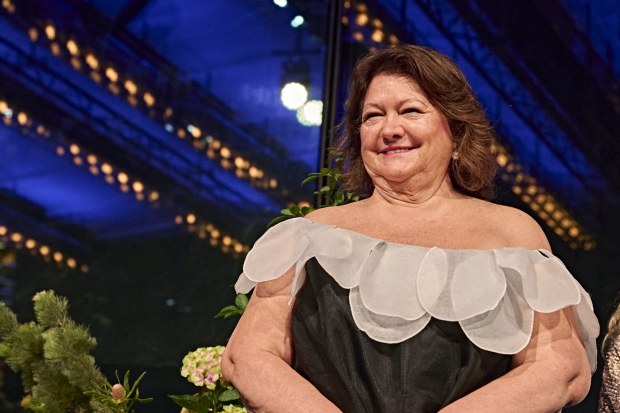Rinehart blames Hancock pay gap on ‘helping women’ into mining
Iron ore magnate Gina Rinehart says a push to bring on more female truck drivers at her Pilbara mines to help them enter the industry has made Hancock Prospecting’s gender pay gap worse because they are some of the company’s lowest paid roles.
The privately held mining company pays its male employees 25 per cent more than women at the median point, and the pay gap narrows to 22 per cent when bonuses, overtime and other financial benefits are included, according to the Workplace Gender Equality Agency.

Gina Rinehart says the 22 per cent gender pay gap at her Hancock Prospecting is the temporary result of helping women enter the mining industry. Michael Quelch
Both pay gaps exceed the industry median of 12.3 per cent on base pay and 15.1 per cent on total pay.
Most mining and resources companies have said their pay gaps are due to women opting out of working fly-in, fly-out roles at remote mines because they are more likely to have domestic and family duties than men. These are some of the industry’s highest-paid roles, because of the sacrifice and long hours they entail.
On the flipside, Hancock said it has worked hard to lift its share of female truck drivers to 39 per cent – or 204 women – but pay was low for these entry-level roles. Hancock has 2554 male and 807 female employees, including Mrs Rinehart as executive chairman.
The wealth the iron ore magnate derives from Hancock pushed her to the top of the Financial Review Rich Women List, released on Wednesday, with a $37.6 billion fortune.
“Many women who join our companies haven’t worked in our industry before, so they often start in entry-level positions,” Mrs Rinehart said.
“But [they] gain experience, and then we offer them pathways to more senior positions and opportunities from there.”
Mrs Rinehart decried the gap measure as too simplistic, because it did not take into account the seniority of roles.
“There is no discrimination in our Hancock operations. Those who work the same job receive the same pay,” she told The Australian Financial Review.
She said Hancock was working hard to get more women into mining through initiatives such as a recruitment campaign called Building An Exceptional Future, customised support and training, and the introduction of “even time” rosters that provide for equal periods on and off mine sites, and are considered more family-friendly.
The company’s chief executive of operations, Gerhard Veldsman, said if Hancock did not employ any female truck drivers its total pay gap would be about 10 per cent,
“But how does that help women?” he asked, adding some drivers would be promoted to leadership roles.
‘Mining sector doing a lot to reduce the gap’
WGEA data shows that women make up 44 per cent of the bottom quartile of earners at Hancock, but just 24 per cent of its entire workforce. Women account for 13 per cent of the top quartile earners.
But Mr Veldsman noted the women in the mining industry were paid more than men “in every other industry”.
“So the mining industry is actually doing a lot to reduce the ‘gap’ on a national basis.”
Fortescue Metals, whose shares are the source of wealth for Australia’s second-richest woman, Nicola Forrest, has a lower gap in total pay than Hancock of 14.6 per cent in favour of men. But only 20 per cent of its truck drivers are women.
Businesses run by other members of the Rich Women list tended to have smaller gender pay gaps, with for instance Melanie Perkins’ online design giant Canva and Jo Horgans’ cosmetics chain Mecca Brands both around 10 per cent in favour of men, versus the 19 per cent Australian average.

Bianca and Allegra Spender’s fashion house Carla Zampatti was one of the few companies where median pay for women outstripped men, to the tune of 19.8 per cent.
One outlier was Lorna Jane Clarkson’s eponymous activewear chain, which recorded a whopping 37.1 per cent median pay gap in favour of men, despite them making up only 3 per cent of the company’s headcount of 1429.
In a statement to the WGEA, Clarkson blamed the gap on an overhaul of her company’s information technology systems, which required hiring skilled specialists from a candidate pool that was “predominantly male”.
She vowed to correct the imbalance in Lorna Jane’s technology team – which is 18 per cent female – in part by encouraging women to transfer from elsewhere in the business. She noted that one of the IT team’s latest recruits had no technology experience and previously worked in one of the company’s retail stores.
Subscribe to gift this article
Gift 5 articles to anyone you choose each month when you subscribe.
Subscribe nowAlready a subscriber?
Introducing your Newsfeed
Follow the topics, people and companies that matter to you.
Find out moreRead More
Latest In People
Fetching latest articles